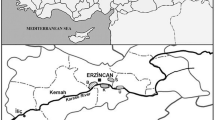Abstract
Pyxine cocoes (Sw.) Nyl., foliose lichen is widespread in the region and grows luxuriantly on the various substrata. For the elemental concentration and biochemical parameters, P. cocoes were collected from the Mandi district and were analysed to assess their tolerance to heavy metals. Six parameters were estimated, including total chlorophyll concentration, carotenoid, protein, flavonoid, phenolic content, and heavy metals (Arsenic, Lead, Cadmium, Nickel, Copper), that are commonly used to determine pollution levels. At a heavily contaminated site, the species accumulated maximum amounts of Pb > Ni > Cu > As > Cd. Most metal concentrations at various sites were significant when compared to the control site. Moreover, total chlorophyll concentration, carotenoid, protein, flavonoid, and total phenolic seem to be the most effective and interesting variables for estimating the level of air pollution in an area. Total chlorophyll, flavonoid, and total phenolic were significantly greater at the moderately polluted site, whilst carotenoid or protein was high at the non-polluted site. The current research concludes that P. cocoes is resistant to inorganic contamination and can be used as a biomonitoring tool for air quality in the region.



Similar content being viewed by others
References
Arnon DI (1949) Copper enzymes in isolated chloroplasts photophenoloxidase in Beta vulgaris. Plant Physiol 24:1–15
Awasthi DD (2007) A compendium of the Macrolichens from India, Nepal and Sri Lanka. Bishen Singh Mahendra Pal Singh Publishers, Dehradun, pp 1–580
Carignan J, Simonetti A, Gariépy C (2002) Dispersal of atmospheric lead in northeastern North America as recorded by epiphytic lichens. Atmos Environ 36(23):3759–3766
Garty J (2001) Biomonitoring atmospheric heavy metals with lichens: theory and application. Critical Rev Plant Sci 20(4):309–371
Garty J, Tamir O, Hassid I, Eshel A, Cohen Y, Karnieli A, Orlovsky L (2001) Photosynthesis, chlorophyll integrity, and spectral reflectance in lichens exposed to air pollution. J Environ Qual 30(3):884–893
Kirchner G, Daillant O (2002) The potential of lichens as long-term biomonitors of natural and artificial radionuclides. Environ Pollut 120(1):145–150
Kumari A (2019) Heavy metals accumulation and physiological changes in the lichens growing in the vicinity of coal-based thermal power of Kanti (Muzaffarpur), Bihar. India Inter J Plant Environ 5(03):165–169
Lowry OH, Rosebrough NJ, Farr AL, Randall RJ (1951) Protein measurement with the Folin phenol reagent. J Biol Chem 193:265–275
Maclachlan S, Zalik S (1963) Plastid structure, chlorophyll concentration, and free amino acid composition of a chlorophyll mutant of barley. Can J Bot 41(7):1053–1062
Malick CP, Singh MB (1980) Phenolics, Plant Enzymology and Histoenzymology. Kalyani Publishers, New Delhi
Nayaka S, Upreti DK, Pandey V, Pant V (2005) Manganese (Mn) in lichens growing on magnasite rocks in India. Bull Bri Lic Soc 97:66–68
Neumann D, Lichtenberger O, Günther D, Tschiersch K, Nover L (1994) Heat-shock proteins induce heavy-metal tolerance in higher plants. Planta 194(3):360–367
Pirintsos SA, Loppi S (2008) Biomonitoring atmospheric pollution: the challenge of times in environmental policy on air quality. Environ Pollut 151(2):269–271
Prasad MNV (1997) Trace metal. In: Prasad MNV (ed) Plant physiology. Wiley, New York, pp 207–249
Purvis OW, Chimonides PJ, Jones GC, Mikhailova IN, Spiro B, Weiss DJ, Williamson BJ (2004) Lichen biomonitoring near Karabash Smelter Town, ural mountains, Russia, one of the most polluted areas in the world. Proc R Soc Lond Ser B 271(1536):221–226
Satya UDK (2015) Air quality assessment by Rinodina sophodes with reference to seasonal variation and traffic influence in india. Int J Curr Microbiol Appl Sci 4(9):549–559
Saxena S, Upreti DK, Sharma N (2007) Heavy metal accumulation in lichens growing in north side of Lucknow city. India J Environ Biol 28(1):49–51
Schreiber UBWN, Bilger W, Neubaue C (1995) Chlorophyll fluorescence as a nonintrusive indicator for rapid assessment of in vivo photosynthesis. In Ecophysiology of photosynthesis Springer, Berlin, Heidelberg
Shukla V, Upreti DK (2007) Physiological response of the lichen Phaeophyscia hispidula (Ach.) Essl., to the urban environment of Pauri and Srinagar (Garhwal). Himal India Environ Pollut 150(3):295–299
Shukla V, Patel DK, Upreti DK, Yunus M (2012) Lichens to distinguish urban from industrial PAHs. Environ Chem Lett 10(2):159–164
Thakur M, Mishra GK, Nayaka S, Chander H (2020) An assessment of lichens diversity from Mandi District, Himachal Pradesh. India Int J Plant Environ 6(04):277–282
Zhishen J, Mengcheng T, Jianming W (1999) The determination of flavonoid contents in mulberry and their scavenging effects on superoxide radicals. Food Chem 64(4):555–559
Author information
Authors and Affiliations
Contributions
MT prepared the manuscript; DK supervised and edited the study. The authors thoroughly revised the manuscript before its submission.
Corresponding authors
Ethics declarations
Conflict of interest
The authors declare that they have no conflict of interest.
Additional information
Handling Editor: Vijay Pratap Singh
Publisher's Note
Springer Nature remains neutral with regard to jurisdictional claims in published maps and institutional affiliations.
Rights and permissions
About this article
Cite this article
Thakur, M., Kapoor, B., Kapoor, D. et al. Physiological Alterations and Heavy Metal Accumulation in the Lichen Pyxine cocoes (Sw.) Nyl. of Mandi District, Himachal Pradesh. J Plant Growth Regul 42, 415–422 (2023). https://doi.org/10.1007/s00344-021-10560-7
Received:
Accepted:
Published:
Issue Date:
DOI: https://doi.org/10.1007/s00344-021-10560-7




